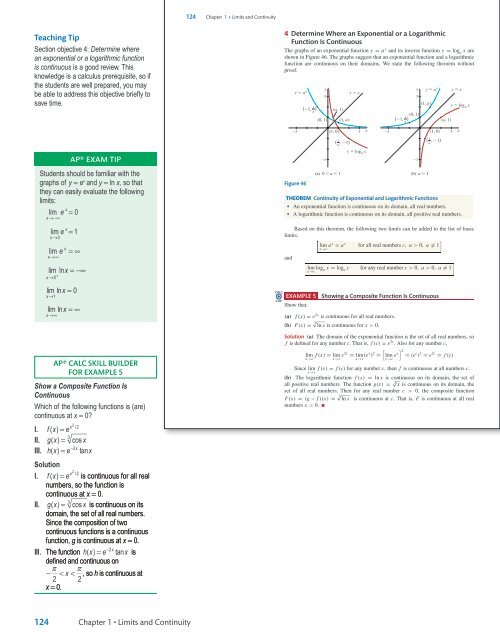Sullivan Microsite DigiSample
Create successful ePaper yourself
Turn your PDF publications into a flip-book with our unique Google optimized e-Paper software.
<strong>Sullivan</strong> AP˙<strong>Sullivan</strong>˙Chapter01 October 8, 2016 17:4<br />
<strong>Sullivan</strong><br />
124 Chapter 1 • Limits and Continuity<br />
Teaching Tip<br />
Section objective 4: Determine where<br />
an exponential or a logarithmic function<br />
is continuous is a good review. This<br />
knowledge is a calculus prerequisite, so if<br />
the students are well prepared, you may<br />
be able to address this objective briefly to<br />
save time.<br />
4 Determine Where an Exponential or a Logarithmic<br />
Function Is Continuous<br />
The graphs of an exponential function y = a x and its inverse function y = log a x are<br />
shown in Figure 46. The graphs suggest that an exponential function and a logarithmic<br />
function are continuous on their domains. We state the following theorem without<br />
proof.<br />
y a x<br />
1<br />
(1, )<br />
a<br />
y<br />
3<br />
(0, 1)<br />
(a, 1)<br />
(1, a)<br />
y x<br />
y y a x<br />
3<br />
(1, a)<br />
(0, 1) 1<br />
(1, )<br />
a<br />
(a, 1)<br />
(1, 0)<br />
y x<br />
y log a x<br />
Students should be familiar with the<br />
graphs of y = e x and y = ln x, so that<br />
they can easily evaluate the following<br />
limits:<br />
x<br />
lim e = 0<br />
x→−∞<br />
x<br />
lim e = 1<br />
x→0<br />
x<br />
lim e<br />
x→∞<br />
=∞<br />
lim lnx<br />
=−∞<br />
+<br />
x→0<br />
lim lnx<br />
= 0<br />
x→1<br />
lim lnx<br />
=∞<br />
x→∞<br />
AP® Exam Tip<br />
AP® CaLC skill builder<br />
for example 5<br />
Show a Composite Function Is<br />
Continuous<br />
Which of the following functions is (are)<br />
continuous at x = 0?<br />
2<br />
x /2<br />
I. fx ( ) = e<br />
II. gx ( ) =<br />
3 cos x<br />
III. hx ( ) = e −2x<br />
tanx<br />
Solution<br />
2<br />
x /2<br />
I. fx ( ) = e is continuous for all real<br />
numbers, so the function is<br />
continuous at x = 0.<br />
II. gx ( ) = 3 cos x is continuous on its<br />
domain, the set of all real numbers.<br />
Since the composition of two<br />
continuous functions is a continuous<br />
function, g is continuous at x = 0.<br />
III. The function hx ( ) = e −2x<br />
tanx<br />
is<br />
defined and continuous on<br />
π π<br />
− < x < , so h is continuous at<br />
2 2<br />
x = 0.<br />
CALC<br />
CLIP<br />
3 (1, 0)<br />
3 x<br />
Figure 46<br />
3<br />
(a) 0 a 1<br />
1<br />
( , 1)<br />
a<br />
y log a x<br />
3 3<br />
3<br />
(b) a 1<br />
1<br />
( , 1)<br />
a<br />
THEOREM Continuity of Exponential and Logarithmic Functions<br />
• An exponential function is continuous on its domain, all real numbers.<br />
• A logarithmic function is continuous on its domain, all positive real numbers.<br />
Based on this theorem, the following two limits can be added to the list of basic<br />
limits.<br />
lim<br />
x→c ax = a c for all real numbers c, a > 0, a = 1<br />
and<br />
lim log<br />
x→c<br />
a x = log a c for any real number c > 0, a > 0, a = 1<br />
EXAMPLE 5<br />
Show that:<br />
Showing a Composite Function Is Continuous<br />
(a) f (x) = e 2x is continuous for all real numbers.<br />
(b) F(x) = 3√ ln x is continuous for x > 0.<br />
Solution (a) The domain of the exponential function is the set of all real numbers, so<br />
f is defined for any number c. That is, f (c) = e 2c . Also for any number c,<br />
[<br />
lim f (x) = lim<br />
x→c x→c e2x = lim(e x ) 2 = lim ex] 2<br />
= (e c ) 2 = e 2c = f (c)<br />
x→c x→c<br />
Since lim f (x) = f (c) for any number c, then f is continuous at all numbers c.<br />
x→c<br />
(b) The logarithmic function f (x) = ln x is continuous on its domain, the set of<br />
all positive real numbers. The function g(x) = 3√ x is continuous on its domain, the<br />
set of all real numbers. Then for any real number c > 0, the composite function<br />
F(x) = (g ◦ f )(x) = 3√ ln x is continuous at c. That is, F is continuous at all real<br />
numbers x > 0. ■<br />
x<br />
124<br />
Chapter 1 • Limits and Continuity<br />
TE_<strong>Sullivan</strong>_Chapter01_PART II.indd 7<br />
11/01/17 9:55 am




